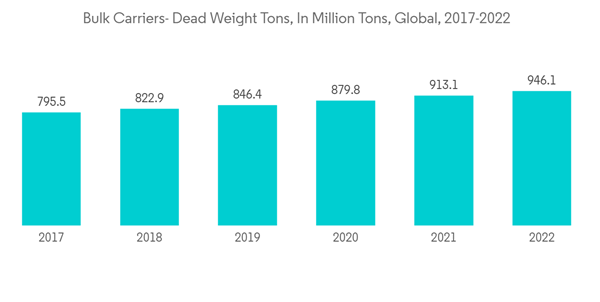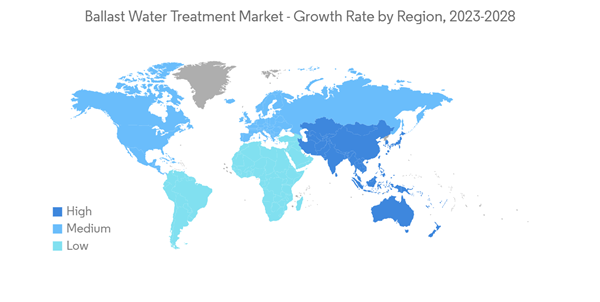The ballast water treatment market is expected to grow at a CAGR of greater than 32% during the forecast period.
The COVID-19 pandemic harmed the market for ballast water treatment. Worldwide lockdowns and strict regulations imposed by the governments caused a major setback as most of the production hubs were shut down. However, the industry recovered since 2021 and is anticipated to grow significantly over the next few years.
This product will be delivered within 2 business days.
The COVID-19 pandemic harmed the market for ballast water treatment. Worldwide lockdowns and strict regulations imposed by the governments caused a major setback as most of the production hubs were shut down. However, the industry recovered since 2021 and is anticipated to grow significantly over the next few years.
Key Highlights
- The principal factor driving the ballast water treatment system is the growing focus on preserving and protecting the marine ecosystem from pollutants and other toxic species. The physical disinfection technology adopted for the treatment of ballast water dominated the ballast water treatment market in terms of market size.
- On the flip side, the massive installation and maintenance expense is hampering the market growth.
- The latest laws issued by the United States Coast Guard (USCG) and International Maritime Organization (IMO) concerning the obligatory usage of the system are likely to act as an opportunity for the global market during the forecast period.
- Asia-Pacific region is estimated to witness healthy growth over the assessment period in the ballast water treatment market due to the increasing usage of the system across the globe.
Ballast Water Treatment Market Trends
Bulk Carriers by Fleet Type to Drive the Market
- A bulk carrier, also known as a bulker, is a merchant ship specifically intended to transport unpackaged bulk goods in its cargo holds, such as grains, coal, ore, steel coils, and cement. Bulk carriers are vital to the shipping industry because of the ease of transporting vast volumes of goods.
- The bulk carriers' segment is anticipated to observe a notable extension in the Ballast water treatment market during the forecast period. Today's bulk carriers are specially designed to maximize capacity, safety, efficiency, and durability. Japan, the Republic of Korea, and China account for the world's primary bulk carrier production countries.
- The ballast water treatment market is facing increased demand for treatment technologies ahead of an International Maritime Organization (IMO) compliance deadline in 2024.
- The United Nations Conference on Trade and Development, in its review of the Maritime Transport 2022 report, stated the fact that since 2017, the Marine Environmental Protection Committee (MEPC) established an experience-building phase (EBP) associated with the Ballast Water Management (BWM) Convention, 2004, to carry out a systematic and evidence-based review of this Convention. Following a data analysis report on the EBP, the MEPC, in June 2022, agreed in principle to develop a BWM Convention Review Plan. As of 15 July 2022, the BWM Convention had 91 contracting states representing 92% of the gross tonnage of the world's merchant fleet.
- According to the UNCTAD report, as of January 2022, the top five ship-owning economies accounted for 53% of global fleet tonnage. Greece accounted for 18% of the 55market, followed by China (13%), Japan (11%), Singapore (6%), and Hong Kong SAR (5%). 94% of global shipbuilding occurred in China, the Republic of Korea, and Japan in 2021.
- It is also anticipated that bulk carriers had the largest deadweight cargo in 2022, around 946 million dwt, approximately 3.5% more than the previous year's value. Bulk carriers also had the largest market share in 2022, accounting for around 43% of total dead weight tonnage worldwide.
- The growing number of bulk carriers with increasing technological advancements, as well as safety procedures to reduce the number of dangerous emissions from such a large number of ships, are predicted to propel the ballast water treatment industry forward.
Asia-Pacific to Dominate the Market
- During the projected period, Asia-Pacific is expected to have the biggest ballast water treatment market share. A significant number of ports and harbors for the trade of oil and chemicals, automotive components, electronic components, and devices, among other things, add to Asia-Pacific market growth.
- The region further offers different types of vessels, such as containers, tankers, and other cargo ships. Since the IMO made it compulsory to install BWT systems in the vessel, it is presumed to drive BWT systems demand. Moreover, current trade volumes and stringent IMO regulations have encouraged the growth of this industry in the region.
- The United Nations Conference on Trade and Development (UNCTAD) stated in its report that the Asia Pacific region had a total of about 957 million dwt, out of which the major share was of bulk carriers with about 45% or close to 438 million dwt of the total share. The dwt of the total fleet saw a minor increase of about 2% in the year 2022 when compared with the previous year.
- According to the UNCTAD assessment, China had the largest share of dead weight tonnage in the whole fleet in 2022. China's share was approximately 115 million dwt or 13% of the total dwt. Bulk carriers were the largest shareholder, accounting for around 68 million deadweight tonnes, or 60% of total dwt.
- According to the Ministry of Industry and Information Technology (MIIT), China placed first in new orders in the first half of 2022, with a share of 50.8% along with the fact that China's shipbuilding industry completed 18.5 million deadweight tons (DWT) worth of orders during the period.
- In March 2021, the Indian government also launched the Maritime India Vision 2030 (MIV) 2030 (a Sagarmala venture) to boost the Indian maritime sector. The country intends to boost cargo flow from 73 million tons per annum (MTPA) to more than 200 MTPA with the MIV 2030 initiative.
- With an increase in ocean freight volumes from numerous nations such as China, India, and South Korea to other areas, this region remains a significant growing market for Ballast Water Treatment. It is projected that future expansion in maritime freight will result in higher acceptance of the Marine Environmental Protection program, which will support market growth.
- An increasing number of container tankers & ships and substantial trade volume in the region further supplement the regional growth.
Ballast Water Treatment Market Competitor Analysis
The ballast water treatment market is partially consolidated and consists of several major players. A few of these players currently dominate the market in terms of market share. Some of the major players in the market include (not in a particular order) ERMA FIRST ESK Engineering S.A., ALFA LAVAL, Xylem (Evoqua Water Technologies LLC), Industrie De Nora S.p.A., and Wärtsilä among others.Additional benefits of purchasing the report:
- The market estimate (ME) sheet in Excel format
- 3 months of analyst support
This product will be delivered within 2 business days.
Table of Contents
1 INTRODUCTION1.1 Study Assumptions
1.2 Scope of the Study
2 RESEARCH METHODOLOGY
3 EXECUTIVE SUMMARY
4 MARKET DYNAMICS
4.1 Drivers
4.1.1 Adoption of Physical Disinfection Technology for Treatment of Ballast Water
4.1.2 Growing Focus on Preserving and Protecting the Marine Ecosystem
4.2 Restraints
4.2.1 Massive Expense on Installation and Maintenance
4.2.2 Other Restraints
4.3 Industry Value Chain Analysis
4.4 Porter's Five Forces Analysis
4.4.1 Bargaining Power of Suppliers
4.4.2 Bargaining Power of Buyers
4.4.3 Threat of New Entrants
4.4.4 Threat of Substitute Products and Services
4.4.5 Degree of Competition
5 MARKET SEGMENTATION (Market Size in Value)
5.1 Fleet Type
5.1.1 Oil Tankers
5.1.2 Bulk Carriers
5.1.3 General Cargo
5.1.4 Container Ships
5.1.5 Other Fleet Types
5.2 Method Type
5.2.1 Physical
5.2.2 Chemical
5.3 Geography
5.3.1 North America
5.3.2 Europe
5.3.3 Asia-Pacific
5.3.4 Rest of the World
6 COMPETITIVE LANDSCAPE
6.1 Mergers and Acquisitions, Joint Ventures, Collaborations, and Agreements
6.2 Market Share (%)**/Ranking Analysis
6.3 Strategies Adopted by Leading Players
6.4 Company Profiles*
6.4.1 ALFA LAVAL
6.4.2 ATLANTIUM TECHNOLOGIES LTD.
6.4.3 BIO-UV Group
6.4.4 DESMI A/S
6.4.5 Ecochlor
6.4.6 ERMA FIRST ESK Engineering S.A.
6.4.7 GEA Group Aktiengesellschaft
6.4.8 Headway Technology Group (Qingdao) Co. Ltd.
6.4.9 Industrie De Nora S.p.A.
6.4.10 JFE Engineering Corporation
6.4.11 MITSUBISHI HEAVY INDUSTRIES, LTD.
6.4.12 Optimarin
6.4.13 PANASIA CO,LTD
6.4.14 Scienco/FAST (BioMicrobics)
6.4.15 Wärtsilä
6.4.16 Wuxi Brightsky Electronic Co. Ltd.
6.4.17 Xylem (Evoqua Water Technologies LLC)
7 MARKET OPPORTUNITIES AND FUTURE TRENDS
7.1 Latest Laws Issued Concerning the Obligatory Usage of the System
Companies Mentioned (Partial List)
A selection of companies mentioned in this report includes, but is not limited to:
- ALFA LAVAL
- ATLANTIUM TECHNOLOGIES LTD.
- BIO-UV Group
- DESMI A/S
- Ecochlor
- ERMA FIRST ESK Engineering S.A.
- GEA Group Aktiengesellschaft
- Headway Technology Group (Qingdao) Co., Ltd.
- Industrie De Nora S.p.A.
- JFE Engineering Corporation
- MITSUBISHI HEAVY INDUSTRIES, LTD.
- Optimarin
- PANASIA CO,LTD
- Scienco/FAST (BioMicrobics)
- Wärtsilä
- Wuxi Brightsky Electronic Co.,Ltd.
- Xylem (Evoqua Water Technologies LLC)
Methodology

LOADING...










